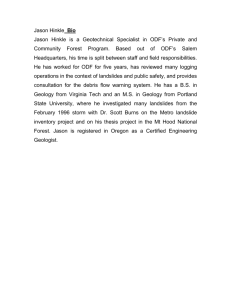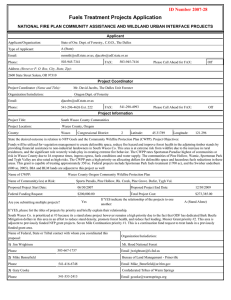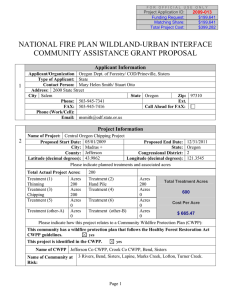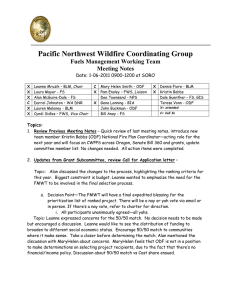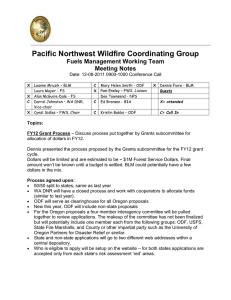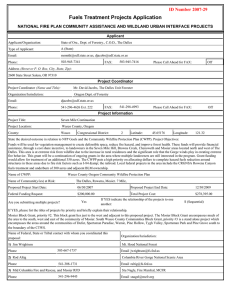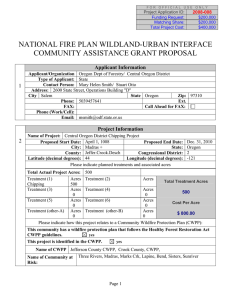Fuels Treatment Projects Application ID Number 2007-65
advertisement
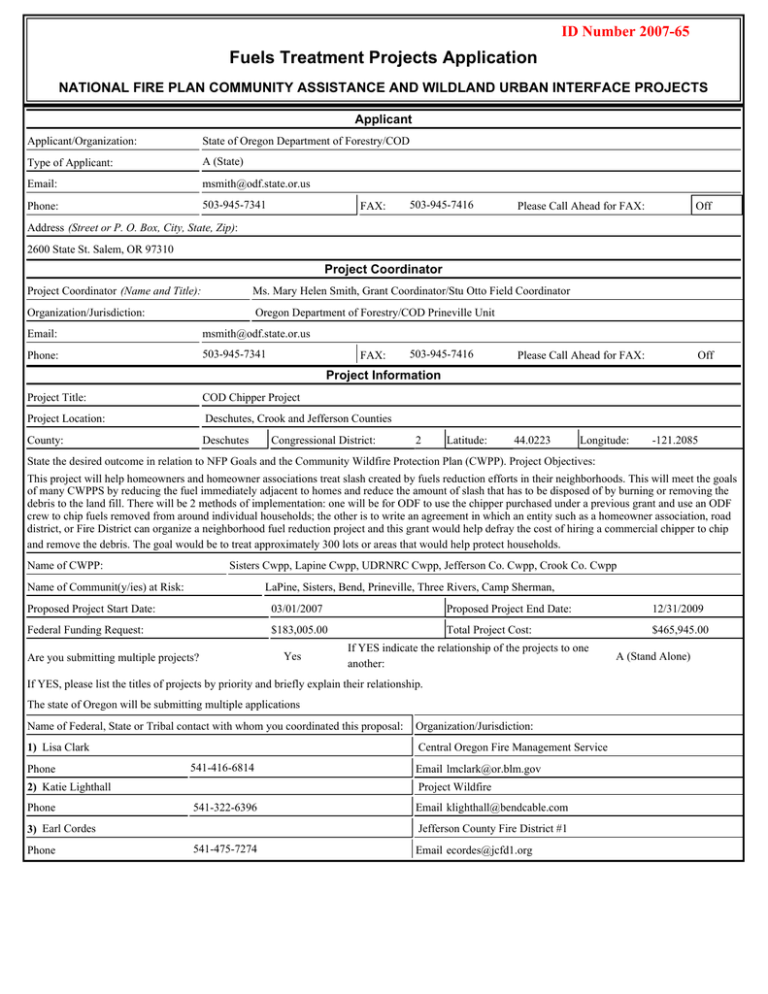
ID Number 2007-65 Fuels Treatment Projects Application NATIONAL FIRE PLAN COMMUNITY ASSISTANCE AND WILDLAND URBAN INTERFACE PROJECTS Applicant Applicant/Organization: State of Oregon Department of Forestry/COD Type of Applicant: A (State) Email: msmith@odf.state.or.us Phone: 503-945-7341 FAX: 503-945-7416 Please Call Ahead for FAX: Off Address (Street or P. O. Box, City, State, Zip): 2600 State St. Salem, OR 97310 Project Coordinator Project Coordinator (Name and Title): Ms. Mary Helen Smith, Grant Coordinator/Stu Otto Field Coordinator Organization/Jurisdiction: Oregon Department of Forestry/COD Prineville Unit Email: msmith@odf.state.or.us Phone: 503-945-7341 FAX: 503-945-7416 Please Call Ahead for FAX: Off Project Information Project Title: COD Chipper Project Project Location: Deschutes, Crook and Jefferson Counties County: Deschutes Congressional District: 2 Latitude: 44.0223 Longitude: -121.2085 State the desired outcome in relation to NFP Goals and the Community Wildfire Protection Plan (CWPP). Project Objectives: This project will help homeowners and homeowner associations treat slash created by fuels reduction efforts in their neighborhoods. This will meet the goals of many CWPPS by reducing the fuel immediately adjacent to homes and reduce the amount of slash that has to be disposed of by burning or removing the debris to the land fill. There will be 2 methods of implementation: one will be for ODF to use the chipper purchased under a previous grant and use an ODF crew to chip fuels removed from around individual households; the other is to write an agreement in which an entity such as a homeowner association, road district, or Fire District can organize a neighborhood fuel reduction project and this grant would help defray the cost of hiring a commercial chipper to chip and remove the debris. The goal would be to treat approximately 300 lots or areas that would help protect households. Name of CWPP: Sisters Cwpp, Lapine Cwpp, UDRNRC Cwpp, Jefferson Co. Cwpp, Crook Co. Cwpp Name of Communit(y/ies) at Risk: LaPine, Sisters, Bend, Prineville, Three Rivers, Camp Sherman, Proposed Project Start Date: 03/01/2007 Federal Funding Request: $183,005.00 Are you submitting multiple projects? Yes Proposed Project End Date: 12/31/2009 Total Project Cost: $465,945.00 If YES indicate the relationship of the projects to one another: If YES, please list the titles of projects by priority and briefly explain their relationship. The state of Oregon will be submitting multiple applications Name of Federal, State or Tribal contact with whom you coordinated this proposal: Organization/Jurisdiction: 1) Lisa Clark Central Oregon Fire Management Service Phone 541-416-6814 2) Katie Lighthall Phone Project Wildfire 541-322-6396 Email klighthall@bendcable.com Jefferson County Fire District #1 3) Earl Cordes Phone Email lmclark@or.blm.gov 541-475-7274 Email ecordes@jcfd1.org A (Stand Alone) Project Planning Information Name of Local Coordinating Group: Cental Oregon Fire Leadership Council For this project, explain the level of cooperation, coordination or strategic planning, through a "Local Coordination Group." If you have not worked with a local coordination group, why not? The level of coordination has been high with individuals, county, state and federal agencies List federal lands that are adjacent to the project and proximity. Deschutes/Ochoco National Forests and Prineville BLM District A) Is there a current hazardous fuels treatment or one that is planned in the next three years on federal land that is adjacent to this project? Yes B) Specifically is this project adjacent to a current prescribed burn project or one that is planned in the next three years on Forest Service lands? Yes Please indicate planned treatments and associated acres: Treatment Thinning Acres 300 Treatment Hand Pile Acres 300 Treatment Machine Pile Acres 0 Treatment Machine Pile Burn Acres 0 Treatment Acres 0 If you have a treatment type other than standard types above: Treatment chipping Acres 300 Project Evaluation Criteria Applications for funding must include narrative responses that address the following criteria. Be sure you address every one briefly, yet thoroughly. 1. Reducing Hazardous Fuels (40 points) A. Describe the community infrastructure that will be protected. This should include how this project implements all or part of the CWPP strategy. (15 points) Response: The main community infrastructure that will be protected is single family dwellings. Reducing and removing fuels around homes will increase defensible space, reduce extreme fire behavior and meet most CWPP goals of complying with ODF Interface Protection Act rules. Chipping the slash created by these treatments will reduce burning and lessen the amount of woody debris moved to land fills. B. Explain how the proposal reduces fire behavior in high hazard areas by describing the fuels to be disposed or removed, the techniques and timing of the treatments, and the treatment location relative to the values to be protected. (15 points) Response: Fire behavior will be reduced by thinning over stocked stands of Ponderosa and Lodgepole pines, remove down and dead trees, pruning and reducing ladder fuels will prevent torching and crowning. Thinning and pruning would be done by hand, brush removal could be done either by mechanical means or hand, slash disposal would be done by chipping. Treatments would take place in the spring or fall. These treatments would be mostly located next to houses and would help protect some of the highest community values. C. Explain how the project is designed to reduce smoke production impacts that affect public health. (10 points) Response: This grant is aimed directly at reducing smoke production by chipping the slash created by fuel reduction in neighborhoods. The last grant helped 158 homeowners chip residue from fuels treatment projects,chipping approximately 2067 yards of material. The grant supported Fire Free efforts with agreements to defray the cost of commercial chippers to dispose of slash collected during Fire Free weekends. In the past 4 years 9 neighborhoods chipped 4,972 yards of slash and serviced an estimated 1040 home sites. 2. Increasing Local Capacity (20 points) A. How would the implementation of the proposed project improve or lead to the improvement of the local economy in terms of jobs and sustainable economic activity assuming that these grant funds would be used as "seed monies" for future projects. i.e. How many community supported jobs would be created and for how long would they expect to last? (10 points) Response: Past grants have provided more than $55,000 in contracted services for local companies helping to improve the local economy by providing jobs to local companies that offer chipping services. This project would continue to provide the same kind of economic stimulation. B. Will biomass that is produced by the project be utilized; if so, in what manner and how much? (10 points) Response: This project has the potential to create thousands of yards of biomass. However,it is hard to determine how much will be used as such. Currently Warm Springs Forest Products is in the process of starting a Co-generation plant and it is possible some of the material could be utilized there. Vulcan Power is also looking at a site in LaPine for electrical cogeneration plant. If this plant is developed, the potential is high for utilization. 3. Demonstrating Community and Intergovernmental Collaboration (20 Points) A. Describe how this project has been collaborated and coordinated with adjacent landowners, local/state/Tribal/federal agencies, and community groups such as neighborhood associations. (10 points) Response: This project would be ongoing from the past Chipper grant. The out reach has been to homeowner associations and Road districts, through CWPP groups, individual contacts from ODF, and Project Wildfire organizational meetings with the Fire Departments B. Describe the communities/partners contributions to this project such as: cash or in-kind contributions, cost share agreements, equipment, or labor (including volunteer work). (10 points) Response: Communities and partners contributions would be individual landowners that treat their lots and move the material to the road so either the ODF chipper or a contractor would chip the material. In this case the fuels treatment would be an in-kind labor contribution. Communities could also stage events in which a group of neighbors would treat their lots and move the material to a road and a contractor would be hired to chip all the properties that participated. All the labor is in-kind. 4. Managing Cost Efficiency (20 points) Discuss the process you used to arrive at your cost structure for the main Project Budget areas such as personnel, equipment, supplies and other (i.e. overhead). In your response please justify: cost per acre, purchase of equipment, percent of overhead, percent of partner or matching funds, and portion of administration cost. (20 points) Response: Personnel: 1 NRS 2, NFP forester @3953/mo. for 6 mo. (field supervisor)=$23,710.00 1 Forest Officer @ 2713/mo. for 6 mo. (chipper crew)= $16,278.00 1 Laborer One @ 2180/mo. for 6 mo. (chipper crew)= $13,080. Total $53,075.00 Fringe benefits: State OPE @ 50% of salary based on State budget guidelines. Travel: NFP Forester 1000 miles/ mo. @ $.44/mile = $440.00 x 6 mo. = $2,640.00 Forest officer in District Engine @ $.92/mile x 1000/miles/mo. = $920.00/mo. x 6 mo. =$5,520.00 Total = $8,160.00. Supplies: chipper blades, blade maintenance and sharpening = $1360.00, Grease,Oil and Fuel = $2470.00 Misc. parts, and filters =$650.00 Safety equipment, = $500.00 Total = $4,980.00. Contractual: Contract chipping @ $160.00 / hr x 480 hours = $76,800.00 Other:District indirect charges @ 15% of personnel costs. $53,075.00 x .15 = $7,961.00 ODF Salem indirect charges @ 3% of the grant = $177,515.00 x .03 =$5,326.00 Landowner in-kind average 50 hours for lot clean up. 12 hours with a chain saw valued at $15.00/hr. = $180.00. 38 hours of hand piling valued at $10.00/hr. = $380.00 Total labor per household or lot = $560.00 x 150 lots to be treated by ODF chipping crew = $84,000.00 The same values would be applied to homeowners using contract chipping $560.00 x 150 homesites or lots =$84,000.00 Fire Districts coordination $25.00/hr x 3-4 hours of coordination meetings monthly $100.00/mo. x 10 mo. x 9 fire districts = $9,000.00 Project Work Form Tasks Coordinate projects Time Frame Responsible Party March 2007 ODF,Fire Districts,Fire Agencies, Homeowner Associations March, 2007 ongoing ODF NFP Forester, ODF Stewardship Forester, Project Wildfire Prepare Chipping agreements, Layout projects, April,2007 ongoing ODF NFP Forester, ODF Stewardship Forester Implement Chipping projects May, 2007 ongoing ODF NFP Forester, ODF Chipper crew Landowners, Homeowner groups and Associations Monitor projects June , 2007 ongoing ODF NFP Forester, ODF Stewardship Forester Process payments to Homeowner groups, Associations June, 2007 ongoing ODF NFP Forester, ODF Stewardship Forester ODF Salem Staff Dec., 2009 ODF NFP Forester, ODF Stewardship Forester ODF Salem Staff Out reach to Landowners, Homeowner groups and associations, Collaborate with Project Wildfire on Fire Free Projects Compile Accomplishment reports, Close out Grant Project Budget Cost Category Description Federal Agency Applicant Landowners Fire Districts Partner 1 Partner 2 Partner 3 Total Personnel $53,075.00 $70,625.00 $0.00 $0.00 $0.00 $123,700.00 $0.00 $0.00 $84,000.00 $9,000.00 $0.00 $93,000.00 $53,075.00 $70,625.00 $84,000.00 $9,000.00 $0.00 $216,700.00 $26,538.00 $35,315.00 $0.00 $0.00 $0.00 $61,853.00 $0.00 $0.00 $0.00 $0.00 $0.00 $0.00 $26,538.00 $35,315.00 $0.00 $0.00 $0.00 $61,853.00 $8,160.00 $0.00 $0.00 $0.00 $0.00 $8,160.00 $0.00 $0.00 $0.00 $0.00 $0.00 $0.00 $8,160.00 $0.00 $0.00 $0.00 $0.00 $8,160.00 $0.00 $0.00 $0.00 $0.00 $0.00 $0.00 $0.00 $0.00 $0.00 $0.00 $0.00 $0.00 $0.00 $0.00 $0.00 $0.00 $0.00 $0.00 $4,980.00 $0.00 $0.00 $0.00 $0.00 $4,980.00 $0.00 $0.00 $0.00 $0.00 $0.00 $0.00 $4,980.00 $0.00 $0.00 $0.00 $0.00 $4,980.00 $76,800.00 $0.00 $0.00 $0.00 $0.00 $76,800.00 $0.00 $0.00 $84,000.00 $0.00 $0.00 $84,000.00 $76,800.00 $0.00 $84,000.00 $0.00 $0.00 $160,800.00 Field/District admin $7,962.00 $0.00 $0.00 $0.00 $0.00 $7,962.00 Salem Admin (3%) $5,490.00 $0.00 $0.00 $0.00 $0.00 $5,490.00 $13,452.00 $0.00 $0.00 $0.00 $0.00 $13,452.00 $183,005.00 $105,940.00 $168,000.00 $9,000.00 $0.00 $465,945.00 $0.00 $0.00 $0.00 $0.00 $0.00 $0.00 Chipper crew in-kind labor Subtotal Fringe Benefits OPE Subtotal Travel mileage Subtotal Equipment Subtotal Supplies Misc parts, filters, fuel Subtotal Contractual contract chipping in-kind labor Subtotal Other Subtotal Total Costs Project (Program) Income 1 (using deductive alternative) 1 Program income is the gross revenue generated by a grant or cooperative agreement supported activity during the life of the grant. Program income can be made by recipients from fees charged for conference or workshop attendance, from rental fees earned from renting out real property or equipment acquired with grant or cooperative agreement funds, or from the sale of commodities or items developed under the grant or cooperative agreement. The use of Program Income during the project period may require prior approval by the granting agency.
